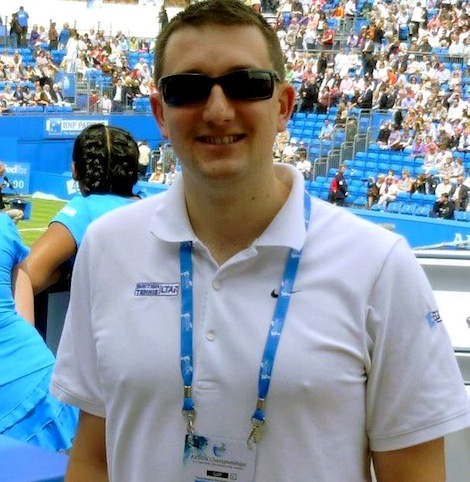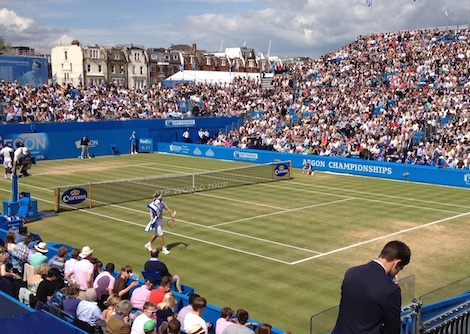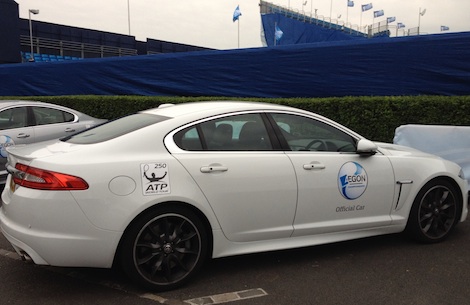 Abraham Lincoln
If given the truth, the people can be depended upon to meet any national crisis...
Abraham Lincoln
If given the truth, the people can be depended upon to meet any national crisis...
 Guildford news...
for Guildford people, brought to you by Guildford reporters - Guildford's own news service
Guildford news...
for Guildford people, brought to you by Guildford reporters - Guildford's own news service
Tennis Blog: The Dragon’s Eye at Queen’s Club
Published on: 11 Jun, 2013
Updated on: 11 Jun, 2013
The Guildford Dragon has a local pair of eyes at this year’s Queen’s Club tournament courtesy of James Avery, Chartered Physiotherapist and Partner at Bevan Wilson Physiotherapy.

James Avery at Queen’s
by James Avery
Monday saw the start of the Aegon Championships but for me it was day three at the event having spent the weekend helping players prepare and cope with the transition from clay to grass.
The weekend was dominated by the ‘quallies’ where those not given a place in the tournament compete for a place in the main draw. This year was interesting as several doubles specialists such as Nenad Zimonjic mounted a charge through the qualifying rounds in an effort to get grass practice and pick up ranking points.
As a result, there was a great deal of banter in the treatment room with some of the more senior players ribbing each other about their performances. Ultimately the doubles players all went out at the final hurdle and were potentially relieved not to make the main singles draw which could have detracted from their doubles chances.

Queen’s Club – the annual curtain-raiser for Wimbledon.
Whilst the qualifiers battled it out, the higher ranked players gradually arrived from the French open or home, while Andy Murray (as widely publicised) had been training at Queen’s Club for several days to aid his recovery from a back injury. So why do players arrive a few days early if possible? The simple answer is acclimatisation, transition and practice.
Acclimatisation – not every player will have been involved in the French Open and those who exit early or develop an injury may take the all too infrequent opportunity to return home. If they are travelling a long distance or across time zones then arriving a few days early allows them to acclimatise to many factors: time zone, weather and temperature, court surface, accommodation, food etc.
Transition – changing surface quickly between tournaments can be a real challenge not only to player performance but also to their body which has to adapt to the very different demands between surfaces.
Players arriving at Queen’s Club will predominantly have been playing on clay for many weeks and the two surfaces could not be more different. Clay tends to slow the ball, keeping it airborne and alive for longer which tests players endurance but allows them to stay more upright and have time to prepare their shot. The loose clay surface also allows players to slide which can reduce the harmful deceleration forces of having to stop suddenly but can put players at risk of ankle sprains etc.
Grass on the other hand is soft which reduces impact forces however it is much faster and balls skid off the turf, staying low which means the players are constantly having to lunge, squat and bend to reach the ball. This coupled with fresh, slippery grass courts which are more inconsistent than clay means that players spend the first few days with sore and tight hamstrings, gluteals (buttocks), groins and lower backs as well as sore elbows and shoulders from the heavy balls.

One of the official cars to transport the players
Practice – like any skill, a few days practice ensures that most players re-familiarise themselves with the grass and how best to play on the surface. That said players vary considerably in their ability to adapt and this may be due to their size, movement efficiency, strength and control. No two players are the same. The amount of practice also has to also be carefully considered as too much practice in too short a time and on a new surface can put them at risk of developing back pain, hamstring strains and other injuries.
So how did the day pan out? A mixture of physio and massage spread across the day. Thankfully the weather was kind and that means that players don’t all arrive for treatment at the same time. There are however peaks and troughs of activity and at times the treatment room can be so busy that we have to improvise with our treatments!
Although the players are now in-tournament most of them are still transitioning having had little time to practice on the grass and so inevitably most treatments have been directed towards tight hamstrings, stiff lower backs, groin pain, shoulder and neck pain.
There has been much debate over the years about whether Roland Garros and Queen’s/Wimbledon should be so close together but for now the players have to adapt and prepare as best they can in the time they have.
Over the next few days we’ll look at training and preparation which can be the difference between success and failure, particularly as a professional tour athlete when time is so limited and the facilities and environment are constantly changing.

"Found any?" - "Nope, it all looks green to me!" (See Opinion: The Future is Congested, the Future is Grey)
www.abbotshospital.org/news/">





Recent Articles
- Latest Evidence in Sara Sharif Trial
- Ash’s New Road Bridge Is Named – and November 23rd Is Opening Day
- Class A in Underwear Leads to Jail Sentence
- Historical Almshouse Charity Celebrates Guildford in Bloom Victory
- Notice: Shalford Renewable Showcase – November 16
- Firework Fiesta: Guildford Lions Club Announces Extra Attractions
- Come and Meet the Flower Fairies at Watts Gallery
- Updated: Royal Mail Public Counter in Woodbridge Meadows to Close, Says Staff Member
- Letter: New Developments Should Benefit Local People
- Open Letter to Jeremy Hunt, MP: Ash’s Healthcare Concerns


Search in Site
Media Gallery
Dragon Interview: Local Artist Leaves Her Mark At One of England’s Most Historic Buildings
January 21, 2023 / No Comment / Read MoreDragon Interview: Lib Dem Planning Chair: ‘Current Policy Doesn’t Work for Local People’
January 19, 2023 / No Comment / Read MoreA3 Tunnel in Guildford ‘Necessary’ for New Homes, Says Guildford’s MP
January 10, 2023 / No Comment / Read More‘Madness’ for London Road Scheme to Go Ahead Against ‘Huge Opposition’, Says SCC Leader
January 6, 2023 / No Comment / Read MoreCouncillor’s Son Starts Campaign for More Consultation on North Street Plan
December 30, 2022 / No Comment / Read MoreCounty Council Climbs Down Over London Road Works – Further ‘Engagement’ Period Announced
December 14, 2022 / No Comment / Read MoreDragon Interview: GBC Reaction to the Government’s Expected Decision to Relax Housing Targets
December 7, 2022 / No Comment / Read MoreHow Can Our Town Centre Businesses Recover? Watch the Shop Front Debate
May 18, 2020 / No Comment / Read More







Recent Comments